
Although scales, chords and arpeggios are very important for building your jazz language, learning to play essential jazz lines is the most direct and effective approach to incorporate a jazzy sound into your playing.
In this blog section you will find transcriptions with tabs of jazz guitar masters with typical lines, patterns, phrases and motifs to help you improve your guitar playing and increase your musical knowledge.

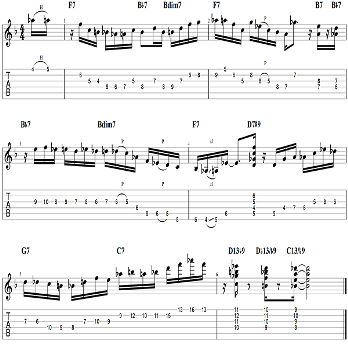
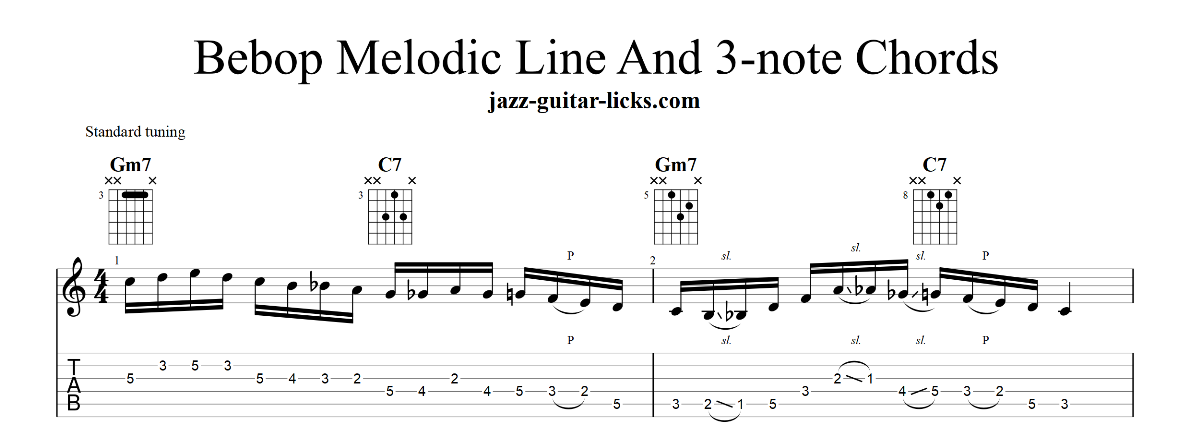
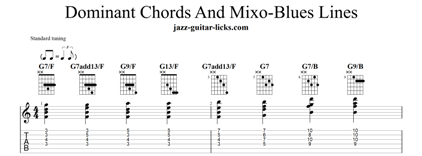
This short guitar lesson provides 14 ways of connecting dominant chord voicings on the same string set (7 and extended) and three easy lines using the Mixo Blues Scale. A free transcription in PDF (or give what you want) is available here on the GUMROAD store.
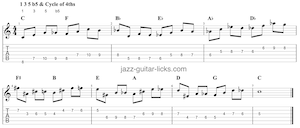
This warm-up exercise for beginner guitarists is designed to help you build dexterity, finger strength, and familiarize yourself with the essential intervals within the context of the cycle of fourths.
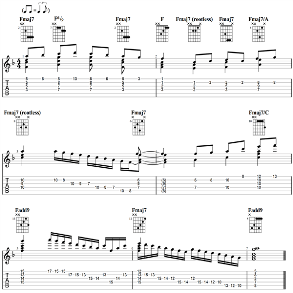
This is a short guitar study that combines various chord voicings and melodic patterns based on the F major scale. This study includes a short video demonstration as well as a free (or give what you want) downloadable PDF guide for reference and practice.
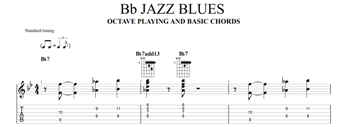
This jazz guitar lesson for beginners provides an easy study to practice octave playing and basic jazz chords over a Blues in Bb. It is available as a YouTube Short Video and a free transcription in PDF with chord shapes tab and standard notation.
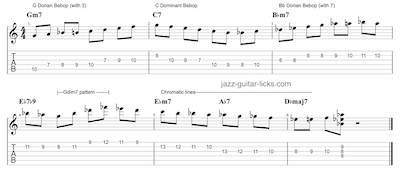
In this brief jazz guitar tutorial you will learn how to use three important jazz scales (Dominant Bebop, Dorian Bebop and Chromatic) and also a diminished 7 arpeggio over ii V chord sequences. Short video and free printable PDF available.

This guitar lesson provides a 12-bar study (free PDF and short video) for practicing the dominant bebop scale, some rootless chords and also three types of arpeggios (min7, dom7 and half-diminished) over a turnaround variation.
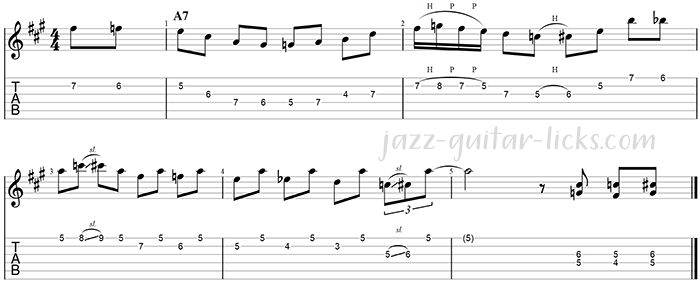
This is a 6 bar jazz blues phrase in A7 inspired by the great Joe Pass, that mixes chromatic passing tones and blues notes with the Mixolydian mode. You'll find here the transcription, an Instagram video et and a brief analysis of the lick.
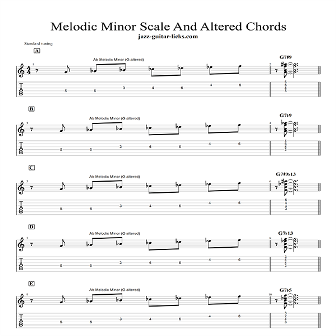
This guitar lesson provides 10 easy exercises for understanding the relationship between the Melodic Minor Scale and altered dominant seventh chords. This is a free course (or give what you want) with a printable PDF with tab/standard notation and a YouTube short video.
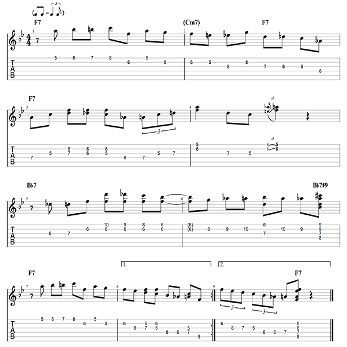
This lesson provides a free PDF music sheet with tab containing some easy jazz blues lines to practice dyads and chromaticisms over two dominant chords. This tutorial is also accompanied by a short YouTube video.
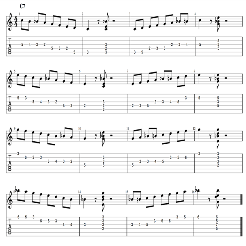
This free guitar lesson for beginners provides an easy exercise with tab/score and video for practicing the Bebop Dominant Scale. The free related PDF is available at the end of the lesson.
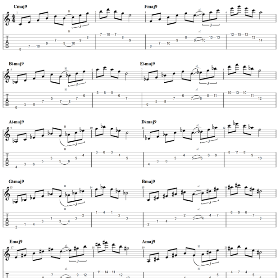
A new free lesson is available for download (or Give What You Want) in Jazz Guitar Lick's GUMROAD store. It's a 24-bar study involving the same major 9th arpeggio pattern following the cycle of fourths. This exercise is a good way to warm-up, untie the fingers and develop the musical ear.

Here are two easy jazz guitar licks published on JGL's Facebook, Youtube and Instagram pages, based on a 2 5 1 sequence in F major (Gm7 | C7 | Fmaj7) implying two arpeggios and a minor triad.
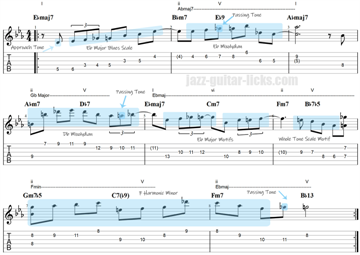
This lesson is the third part of the serie "Jazz Guitar Lines Over Common Chord Changes" that provides easy jazz guitar licks for beginners to play over II V, II V I and I IV II V progressions. These lines are majoritarily built with the major blues scale, the Mixolydian mode and a whole-tone scale motif.

In this guitar lesson with shapes, tab, video and analysis you will learn how to use seventh arpeggios over important jazz chord sequences as minor & major II V , major II V I and I vi ii V progressions. You'll find the link to the PDF at the bottom of the page.
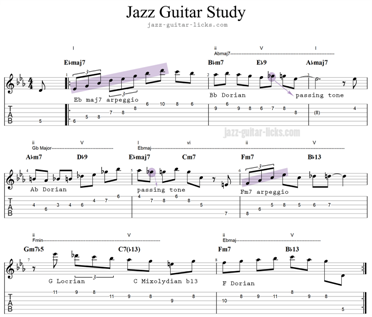
This short jazz guitar study with tab, score and chord charts provides some easy jazz lines to apply over three common chord progressions found in jazz. These licks will help you better understand what scales and modes can be used over basic chord changes. You'll find a link to the free PDF at the end of this lesson.
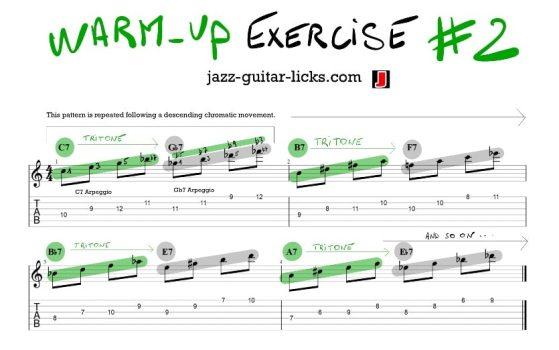
This lesson is about a good warm-up exercise for guitarist implying a short pattern (4 beats) made of dominant seventh arpeggios separated by a tritone (3 whole tones = augmented fourth). This pattern is repeated following a descending chromatic movement.
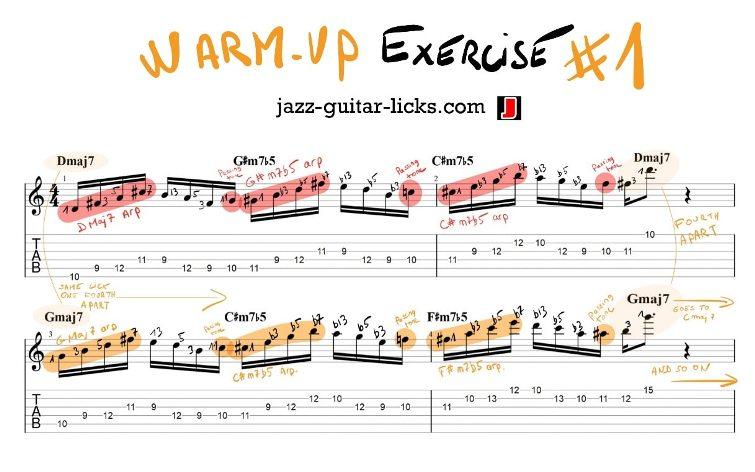
This warm-up exercise for guitar is to repeat a melodic line following the cycle of fourths. This line is made of two bars containing a major seventh arpeggio (1 - 3 - 5 - 7) and two half-diminished arpeggios (1 - b3 - b5 - b7).

A brand new video is now available on JGL's YouTube channel. It's about 10 Pat Martino lines taken from the jazz blues tune "Cisco". You can watch / hear the video below and maybe check out the full tutorial in the "solo transcriptions" section of this website.
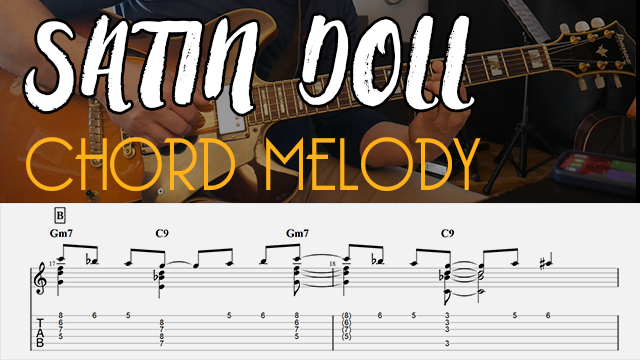
Check out the latest video from the YouTube channel. This is a chord melody arrangement for guitar of Duke Ellington's jazz standard "Satin Doll".
This free lesson with tabs is intended for intermediate players who want to practice some drop 2, drop 3 voicings, walking bass lines, chords inversions and substitutions over one of the most popular jazz tune.

Here is a video transcription for guitar of Ryland by Julian Lage.
Music By Julian Lage From The Album Arclight, available via Mack Avenue Records:
Buy Julian Lage Discography on Amazon
Lesson by Fabrizio Brusca
Oh, Lady Be Good by Lester Young is Second video from the chapter "Jazz Language And Improvisation Techniques Serie".
In this chapter, Fabrizio made a selection of some famous solos that show how jazz phrasing has been developped from 1925 until these days. Each video of the serie (organized in a chronological order) features a history of jazz masters that have contributed to the evolution of jazz.
These lines have been transposed on guitar trying to respect all the original instrument nuances and embellishments.

This video recently posted on the YouTube channel contains 10 Mike stern lines with tabs and standard notation transcribed from the solo of "Chatter".
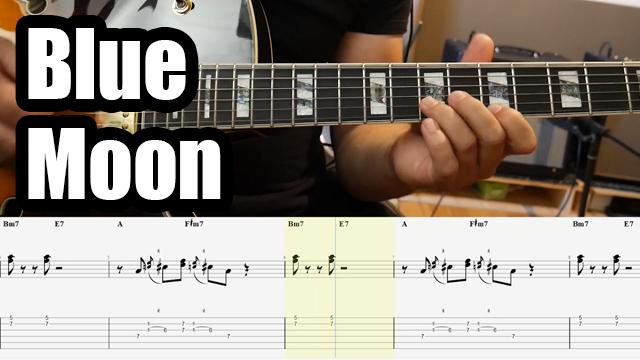
Here is a transcription (tabs, and standard notation) of the guitar comping played by Howard Roberts in the jazz standard Blue Moon with Julie London. You will find in the following:
By Diego Wasserman,
This lesson provides 20 cool 2-5-1 jazz guitar licks by Julian Lage. Lines are played in at least 2 versions, included some melodic analysis.
Tabs are available for download following this link. If you like it, please support my work by sharing it, commenting on the youtube video and subscribing
Tangerine is a song written by Victor Schertzinger and Johnny Mercer, published in 1941. This is one of the most popular jazz standard. This lesson provides an arangement for jazz guitarists inspired by Stan Getz version.
Lesson By Steve Down
I'm super excited to start my new lesson series on one of my favourites 'Midnight Blue' by Kenny Burrell. If you love blues and are looking to dip your toe into jazz then this is a great place to start! Have fun!
PART 1 This is a new series where we are learning the whole of Kenny Burrell's 'Midnight Blue' from his 1963 album of the same name. There will be a new lesson every Saturday where we will learn another chorus from this excellent tune! And there will be TAB on screen!
In this lesson we look at the head of Midnight Blue. The chords, the melody and some of the gear KENNY BURRELL used for the Midnight Blue recording sessions. Next week we will be looking at the first chorus from the solo!
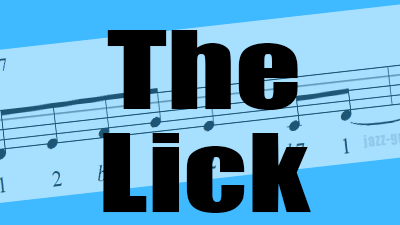
"The Lick" is considered as the most famous phrase in jazz music (and also in other styles). It has been played so many times, by so many players, in so many tunes that it has become a cliche.
Although there are a significant number of common jazz lines, this one is surely the most popular, an essential part of the Bebop language. This guitar lesson with tabs, charts and theory explains what is "The Lick", how it is built and how to apply it in different harmonic contexts.
A brand new PDF method is available for download. It rounds out the two previous eBooks Ionian jazz guitar licks and Dorian jazz guitar licks. This book contains 40 dominant jazz guitar lines with tabs, audio files and theory based on the Mixolydian mode for beginners and intermediate players.
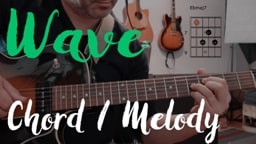
This lesson provides an easy chord melody arrangement for guitar with tablature, standard notation and chord shapes of the bossa nova latin jazz tune "Wave" by Antonio Carlos Jobim.
wave-a.c-jobim-guitar-transcription.pdf (92 Ko)

A new lesson (with YouTube video, analysis and tabs) intended for all jazz, blues, groove enthusiasts and John Scofield fans is now available for free on the website. It contains 10 John Scofield jazz guitar licks transcribed from one of his solo in the tune "Little Walter Rides Again" live at live at Estival Jazz Lugano 2007 with MMW trio (John Medeski, Billy Martin and Chris Wood). They show how Sco used to mix pentatonic scales, blue notes and altered tones.
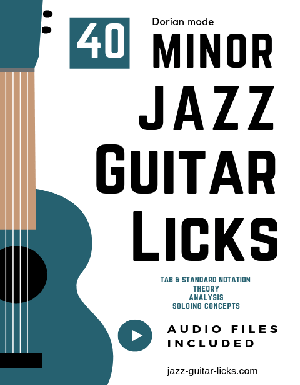
A new printable PDF method is available for download. It contains 40 Dorian jazz guitar patterns with tab, standard notation, audio files, theory and numeral analysis. The licks are suitable for beginners, they are built from the Dorian mode and designed to be played over minor chords. Many theoretical concepts are discussed (arpeggios, diatonic substitution, triad pairs, passing tones, etc)
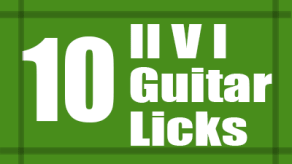
The II-V-I sequence is the most common chord progression played in jazz music and a must know for any guitarist who wants to learn jazz language.
The II, the V and the I (chords and scales) are constructed based on the corresponding second (II), fifth (V) and first (I) step of the major scale.
In this guitar lesson you will learn what's the 2 5 1 progression and how to play easy jazz lines over a 2-5-1 using the most common scales found in jazz music.
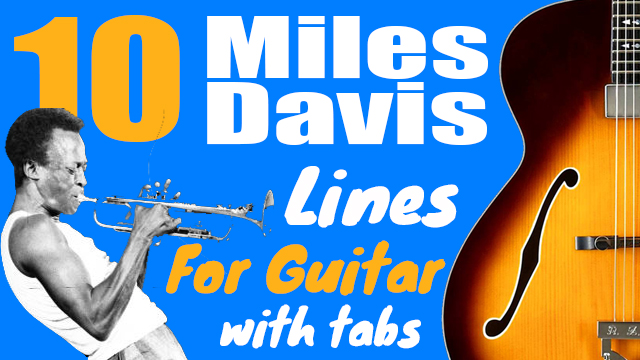
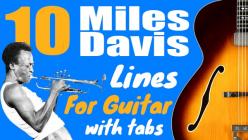
A new video is available on the YouTube channel. It contains 10 easy Miles Davis lines with analysis, audio files, standard notation and tabs overlayed transcribed from Solar, Vierd Blues and Tune Up.
You can also check out the free full course about those 10 Miles Davis licks for guitar.
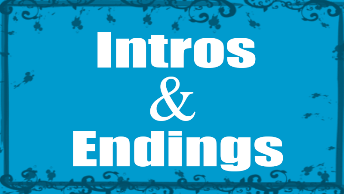
This lesson contains five free guitar studies for beginners that outline the use of arpeggios over a Bb jazz blues progression. There are different kinds of jazz blues progressions. The one that is used in this eBook is built with a secondary dominant (VI7), a passing diminished (#IVdim7) and a turnaround (I7, VI7, iim7, V7).
Edim7
Cm7
F7
Cm7 F7
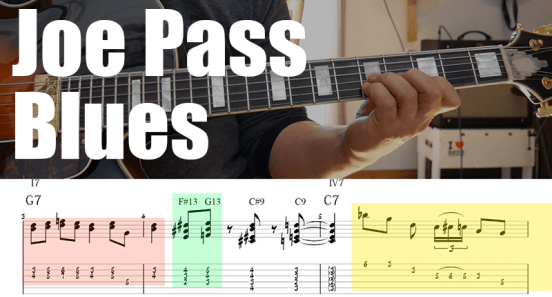
Joe's blues is a 12-bar blues taken from one of the many Joe Pass methods named "Joe Pass on Guitar". This lesson covers the first 24 bars of the original lesson. If you listen to the audio file provided with the book you can hear that there are a lot of mistakes in the transcription. That's why I have decided to transcribe those lines directly from what I heard.
This blog article is related to the video tutorial published on JGL YouTube channel. It contains 10 II V7 jazz bebop guitar patterns with analysis and scale shapes.
These lines come from the first chapter of David Baker's book "How To Play Bebop Vol.2 - Learning the bebop language". They correspond to the first ten exercises of the section named "The Use of The II V7 Progression in Bebop".
You 'll find in this lesson a quick analysis of each pattern with scale diagrams (Dorian, Dorian bebop, Mixolydian, dominant bebop, Mixolydian b13, altered, mixo-blues and half-whole diminished).

 What's a Tritone Substitution?
What's a Tritone Substitution?The tritone substitution is one of the most common substitution found in jazz. The basic application of a tritone chord substitution is to take any 7th chord and play another 7th chord that has its root a tritone away from the original. This guitar lesson demonstrates how you can play scales and arpeggios starting from the b5 (a tritone away) of the V7 chord in a II V I chord progression. This way you will highlight altered tones as the b9 and the #11.

Octave playing is a big part of jazz guitar language, this technique has been popularized by guitarist Wes Montgomery one of the greatest improvisers and jazz genious of all times.
Theoretically, the principle is quite easy to understand. You just have to play lines using two simultaneaous notes separated by twelve semitones. In practice, it is more difficult because of the fingerings.
Indeed, you have to move two fingers at the same time while keeping the same hand position. This lesson provides guitar diagrams and easy guitar lines for a good mastery of this technique.
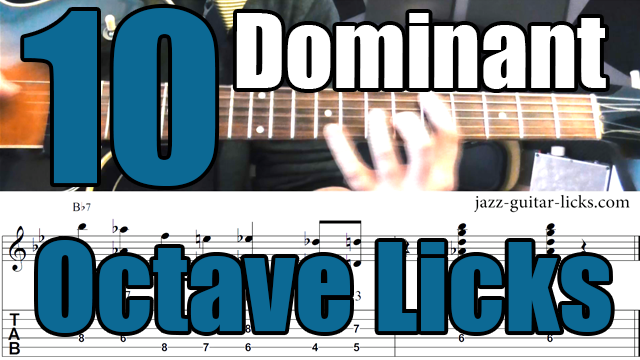
Octave playing technique involves playing the same note on two strings separate by one octave. An octave is 12 semitones higher than the root note. You will find in this blog post a new video from the YouTube Channel, containing 10 dominant octave licks with tabs and standard notation overlayed.
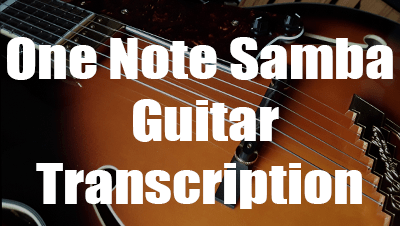
One note samba is a song composed by Antonio Carlos Jobim. The title refers to the main melody of the song, which consists of a serie of identical notes (F and Bb in this arrangement for guitar) with a syncopated rhythm typical of bossa nova and a number of chords typical of this genre.
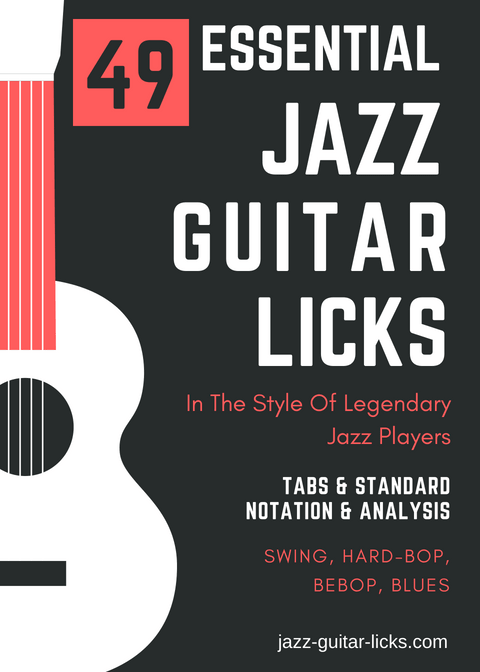 49 Essential Jazz Guitar Licks With Tabs and Analysis
49 Essential Jazz Guitar Licks With Tabs and AnalysisSecure payment by Gumroad / paypal
Practicing jazz guitar licks is a very important aspect of jazz learning. Particularly when these licks are transcribed from improvisations of the greatest jazz musicians of all times (Cannonball Adderley, Barney Kessel, Sonny Rollins, Charlie Christian, Emily Remler, George Benson, Grant Green, Herb Ellis, Jim Hall, Jimmy Raney, Joe Pass, John Scofield, Kenny Burrell, Charlie Parker, Mike Stern and Wes Montgomery) who helped forge the history of jazz music.
This eBook available for download in a PDF format contains 49 effective jazz guitar phrases and patterns with TABS and notation applied to common jazz chord progressions . These patterns both for guitar teachers and students cover different styles from swing to blues, to hard-bop to bebop.
These essential jazz lines arranged for jazz guitarists from beginner to advanced come with easy-to-understand explanations of one of the greatest players improvisational techniques.
Learning these jazz transcriptions make it possible to understand the approach of the great names of jazz to different chord progressions found in many standards as turnarounds, minor and major II-V-I, blues progressions, modal playing.
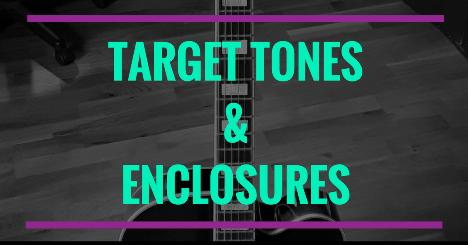
This guitar lesson is about a very important concept used by many jazz improvisers named "Target notes" or "target tones" or "approach notes". It has to do with targeting chord tones by scale or chromatically.
This technique opens the door to another essential type of targeting called "Enclosures" used to surround a chord tone both diatonically and chromatically from above and below.
Understanding and applying "Targeting" will help you solos sound more jazzy and allow you to expand your harmonic knowledge.
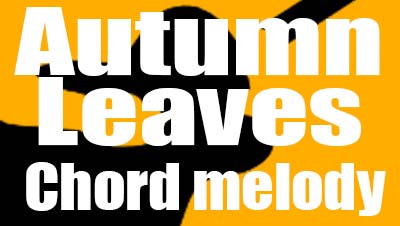
Autumn leaves is one of the most popular non-American jazz standards on pick-up gigs and records. It is a must-know tune for any jazz guitarist and a great choice when you want to play both chords and melody on guitar. This guitar lesson provides an easy chord melody arrangement to play this famous jazz tune.


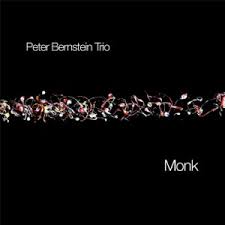
The music of Thelonious Monk is music which evokes many different emotions and ideas in a huge demographic of musicians and instrumentalists. With that in mind, the emotions and ideas evoked by legendary jazz guitarist, Peter Bernstein, in this showcase album range from childish playfulness, faithful to the source of the music, to coherent and thorough modern jazz playing in the upper echelons of technical and interactive ability.
It’s been noted previously in reviews, at the time of the album’s release, that a collection of Monk tunes by a guitarist is a rare occurrence that was a huge breath of fresh air to all those who knew about its existence. I’ve never heard such faithful music made with such individualism and taste without any sense imitation. This is most definitely Bernstein plays Monk and not the other way around.

When a jazz beginner starts to improvise over a II-V-I progression, he generally plays arpeggios corresponding to the chords of the sequence.
In other words, he learns to play minor arpeggios over the minor chord (II), dominant 7th arpeggio over the 7th chord (V) and major arpeggio over the major 7 chord (I). This way the harmony is highlighted without taking risks.
In the long-run there is nothing exciting. That's why there is a nice trick used by number of jazz players to add smoothness to a dominant line. This is a little tip that makes all the difference which consists of playing a major 7th arpeggio over the V7 rooted on its b7 degree.
A new video has been uploaded on the YouTube channel. It is a Barry Galbraith comping study named "Like someone". This is the last study from the Barry Galbraith book "Jazz guitar comping series, vol #3" published by Jamey Aebersold.
Most of the accompaniments studies (comps) in this book are designed to accompany a melody or an improvised solo with bass lines like a pianist would do. It is a very great book to practice jazz guitar comping.

A new video has been uploaded on the youtube channel. It is a jazz guitar transcription of the jazz standard "In a mellow tone" composed by Duke Ellington and performed by Kenny Burrell in 1990.
Here is the Kenny Burrell version on which the transcription is based and the link to the album dedicated to Duke Ellington.
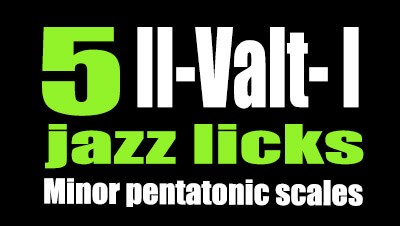

In this lesson we will see how to use the minor pentatonic scale over a II-Valt-I sequence. The principle is simple, it consists in playing three minor pentatonic scales spaced apart of 1 semitone one from the other. This way you will bring out interesting colors to your jazz lines.
Here is a free transcription of the famous soul-jazz tune "Sookie sookie" by Grant Green.
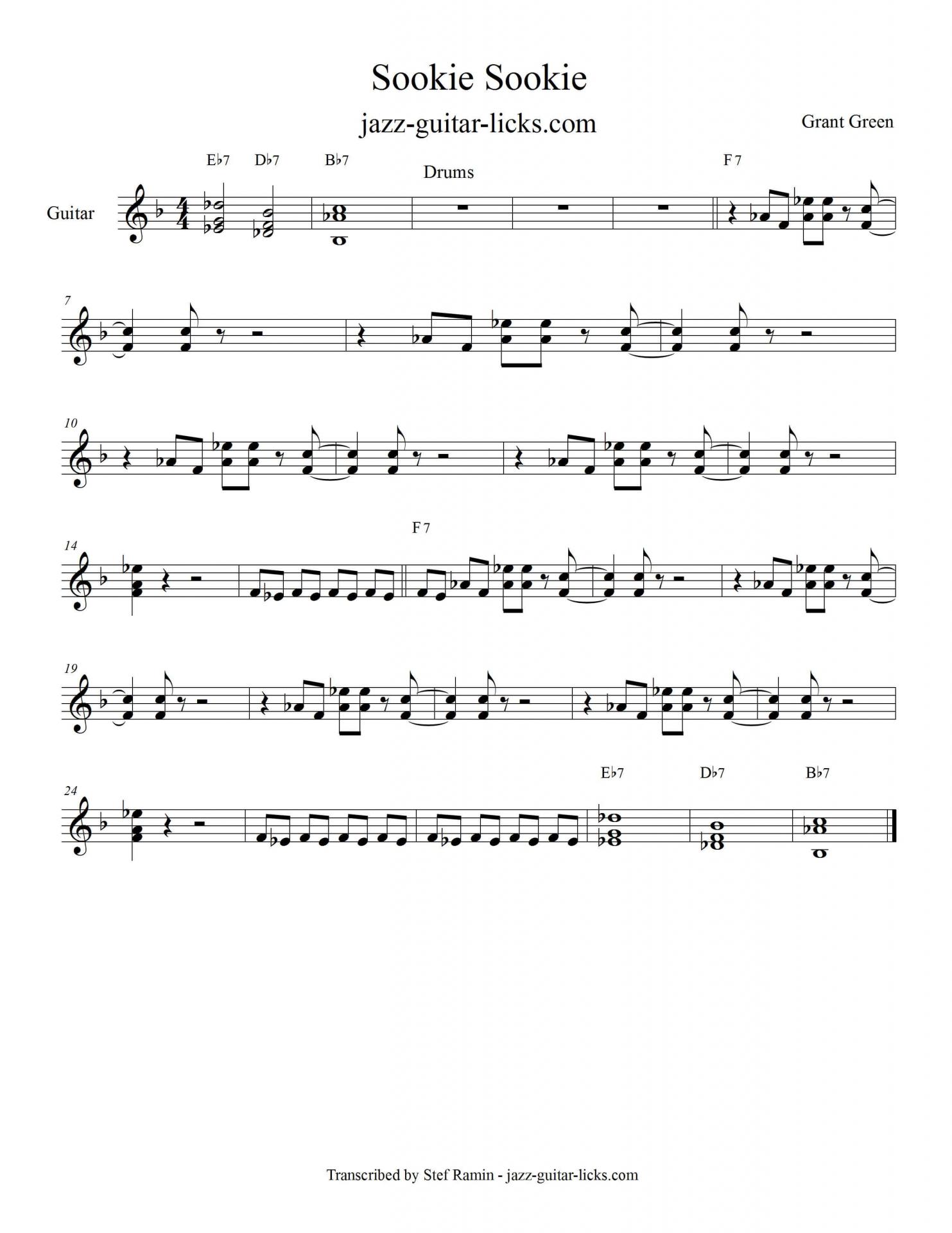
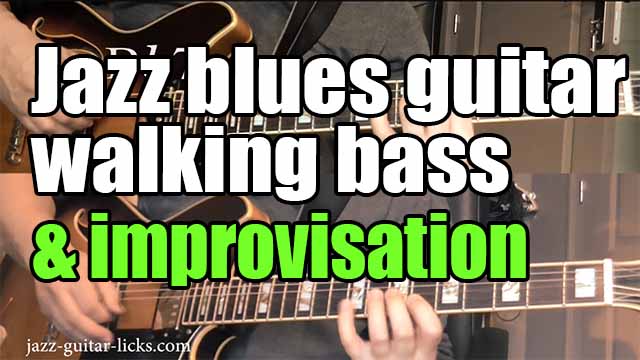
This lesson is about a 12-bar blues in the key of Bb included two guitar transcriptions with tabs : a guitar walking bass line for the accompaniment and a guitar improvisation to solo over.
Note that this study is based on a common blues jazz progression? but with a descending chromatic progression in bars 7 & 8 using three dominant 7th chords (Bb7, A7, Ab7) to approach G7 at the end of the bar 8.
C-7 | G7 | Bb7 G7 | C-7 F7 |
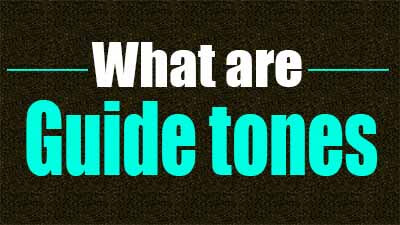

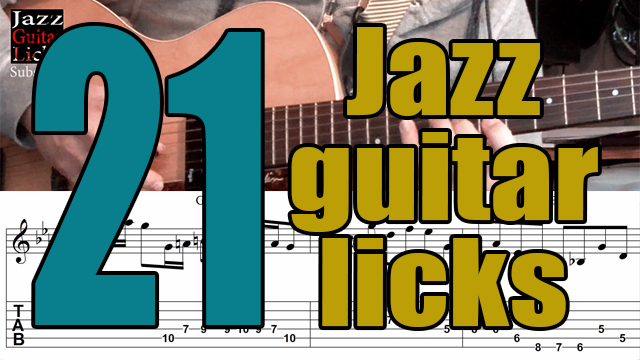
A new video has just been uploaded on the youtube channel. This lesson contains the 21 most recent jazz guitar licks & transcriptions posted on the channel.
Here is the summary :
When you want to play altered jazz guitar lines over a dominant 7th chord, there is an easy and efficient option that is to play a major triad starting on the #11 of the chord you want to improvise over. This way you highlight the b7, #11 and b9 and add tension to your playing.
Let's take an example with a II-V-I sequence in the key of C major. The progression is Dm7 | G7alt | CMaj7.
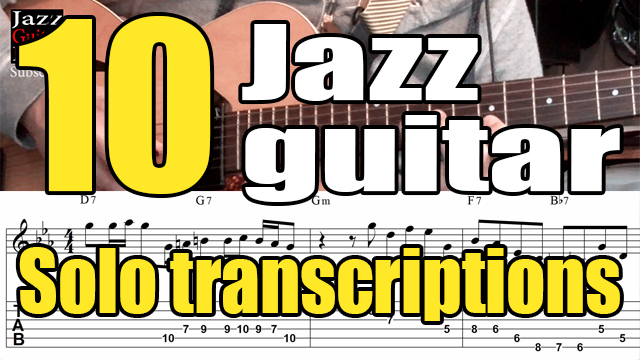
A new video is online on the youtube channel since yesterday. This is a compilation of the best jazz guitar solo transcriptions posted on the youtube channel since one year. This video lesson contains transcriptions of great jazzmen as John Scofield, Charlie Christian, Grant Green, Wes Montgomery, Eric Gale. Here is the timeline:
Charlie Christian ( Benny's buggle) 00:00
Clifford Brown (Jordu) 01:23
Eric Gale (Too blue) 02:22
Grant Green (Grantstand) 02:59
Grant Green (Airegin) 04:00
Grant Green (N°1 Green street) 05:17
Jimmy Raney (Have you met miss Jones) 07:26
John Scofield (Wee) 07:56
Wes Montgomery (Full house) 08:50
Wes Montgomery (Full house) 09:42
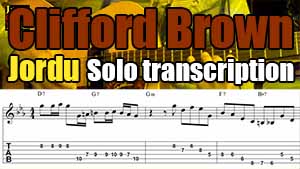

Be jazz guitarist does not mean that you have to play only guitarist's solos. It's very important to transcribe lines of other instruments like sax, trumpet or piano for example. This way you will change your habits and you will play some jazz lines that maybe you would never have played before.
This lesson is about a Clifford Brown trumpet solo transcription in "Jordu". Clifford Brown was an American songwriter and jazz trumpet player. He composed two jazz pieces which have become standards, "Joy spring" and "Daahoud". He has collaborated with jazz players as Art Blakey and Lionel Hampton before forming his own group with the drummer, percussionist and composer Max Roach.
Jordu is a jazz standard written by Irvin "Duke" Jordan. He has been popularised by Clifford Brown and Max Roach quintet in the album that includes the two standards "Joy spring" and "Daahoud" .This is an AABA traditional jazz form in the key of C minor. Referring to the realbook the chord progression is :
D7 G7 | Cm | F7 Bb7 | EbM7
D7 G7 | Cm | Ab7 | G7
G7 C7 | F7 Bb7 | Eb7 Ab7 | Db7
F7 Bb7 | Eb7 Ab7 | Db7 Gb7 | G7
The transcription is focused on the A part only. This will allow you to understand how to improvise and which scale to play over two interesting jazz progressions :
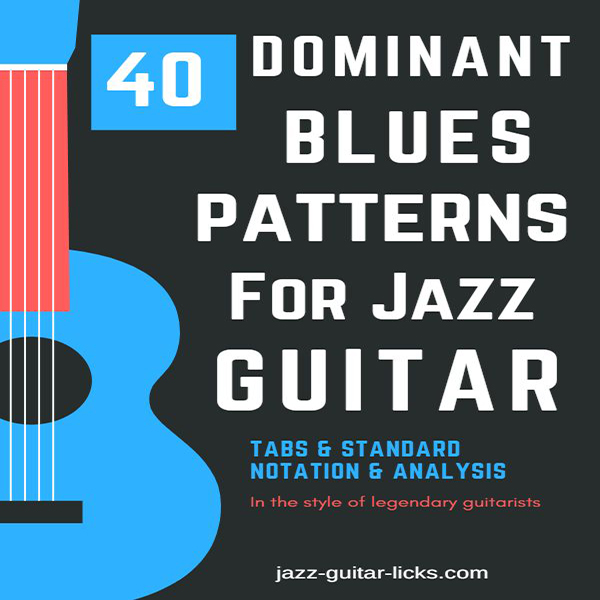
A new PDF eBook is now available for download via the GUMROAD / PAYPAL interface. This jazz method contains 40 jazz, blues licks with tabs, scales charts and two jazz swing backing track in C7.
This PDF booklet is dedicated to the jazz guitar students who wants to improve their jazz, blues playing in the style of Wes Montgomery, Kenny Burrell, Grant Green, Charlie Christian, George Benson, Barney Kessel and more.
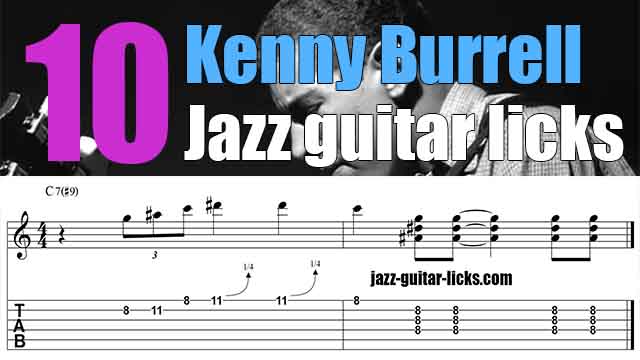
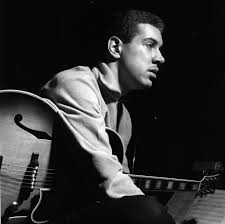
Kenneth Earl "Kenny" Burrell (July 31, 1931) is an American jazz guitarist from Detroit. With Wes Montgomery and Charlie Christian he is one of the most influential jazz guitarist, epitome of good taste and unique swing. His guitar sound is clear, refined and raw, easy to recognize. His guitar playing is unique, grounded in bebop and blues, the man is able to play both blues licks and swinging bebop lines.
He has collaborated with many artists as sideman (Dizzy Gillespie, "Jimmy Hammond" Smith, Billy Holiday, Milt Jackson, Stanley Turrentine, Stan Getz, Chet Baker, The Jones Brothers. ) and recorded many solo albums including the famous "Midnight blue" (Blue note, 1963).
He has played Gibson guitars (ES-175, super 400) for the majority of is career plugged into a Fender deluxe amp.
How smooth can jazz guitar get ? Right here is the answer. Midnight Blue (released in 1963 by blue note records and recorded by Rudy Van Gelder) is one of those records that you just put on, sit back and relaxis. In this album Kenny Burrell is accompanied by the tenor-saxophonist Stanley Turrentine in a pianoless quintet that also includes Ray Barretto on congas (a highly regarded bandleader in his own right who injects a dash of Latin flavor), Major Holley on bass and Bill English on drums. Midnight blue is considered one of the best recordings of Kenny Burrell's career.
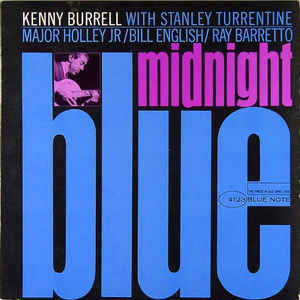
This album is very useful for basic call-and-response type blues phrasing, recommend for anyone trying to learn playing jazz blues on guitar.
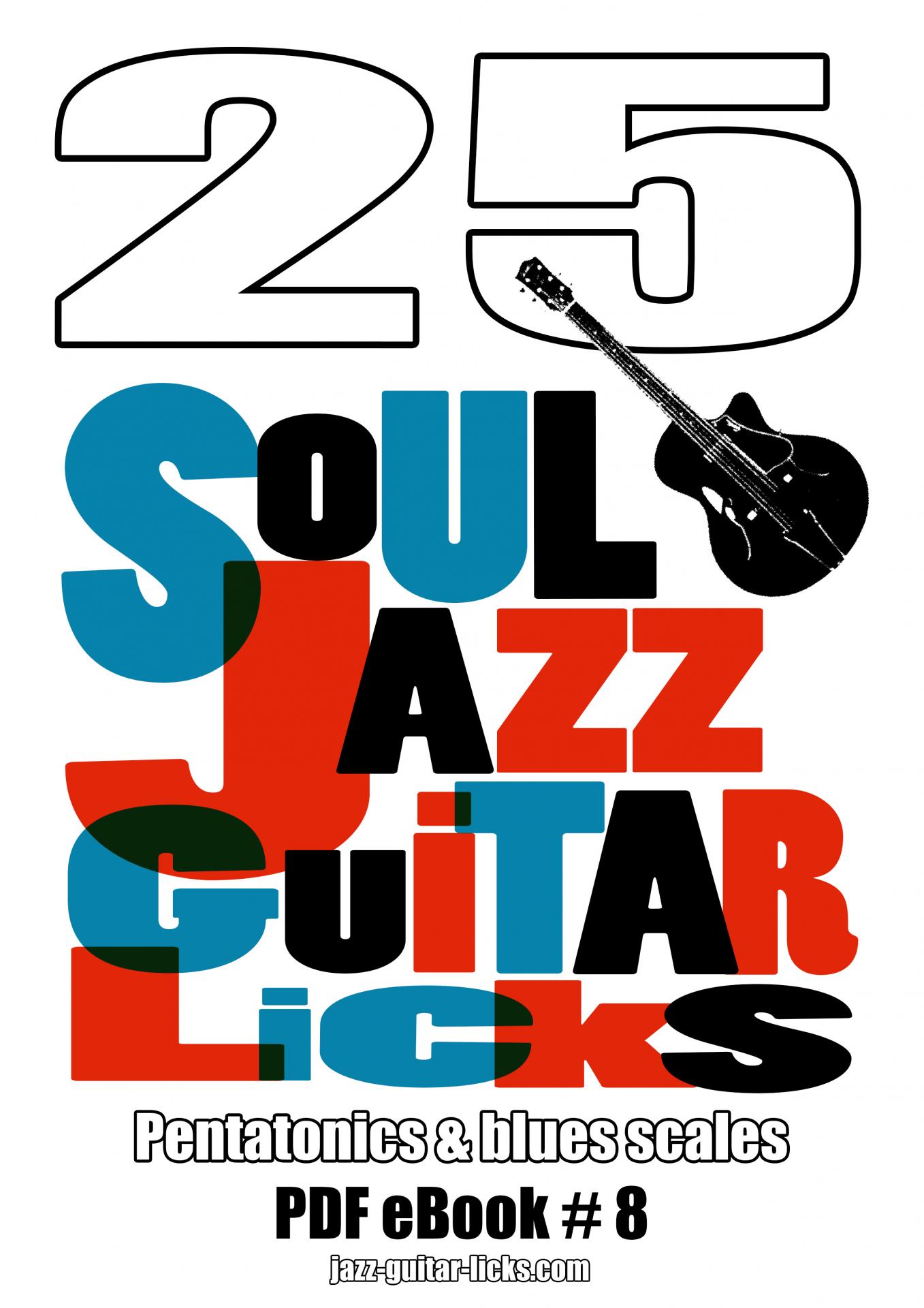
A new printable PDF eBook dedicated to soul jazz guitar licks is now available for download.
Soul jazz (sometimes called "jazz-funk) is a form of jazz commonly associated with hard bop. It has strong influences from blues, rhythm & blues and gospel. You can also go listen to Lou Donaldson, Big John Patton, Jimmy "Hammond" Smith, to soak up this style.
All these licks are two bars licks in the key of Bb7 and inspired by great guitarists as Grant Green, Melvin sparks, Wes Montgomery or Kenny Burrell. They are essentially built with notes from the minor, major pentatonic and minor blues scale.
Each lick is analysed and accompanied by a quality audio file. A backing track is also included in the package.
Why all these licks are in the same key ?
To simplify learning, it's easier to memorize them, then you can make the connection between each lick to built longer guitar solos. Once you have learnt these licks, the aim is to play them in different keys, add notes and fret hand techniques (bends, hammer-on, pull-off, slides) vary the rhythm.
- 1 printable PDF eBook with 25 soul jazz guitar licks in Bb7 with tabs, scales charts, guitar fretboard diagrams (5 boxes for each scales) and analysis.
- 1 soul jazz backing track (Quality mp3 audio file).
- 25 soul jazz guitar licks audio files (Quality mp3 audio files).